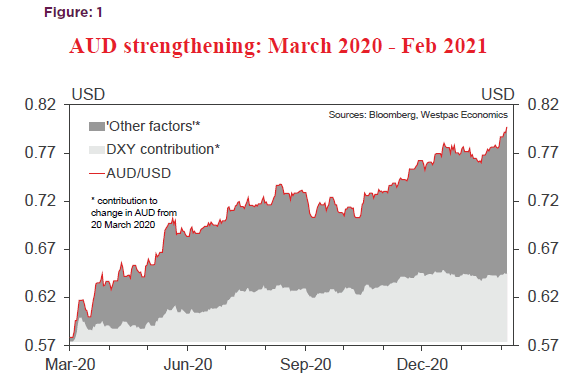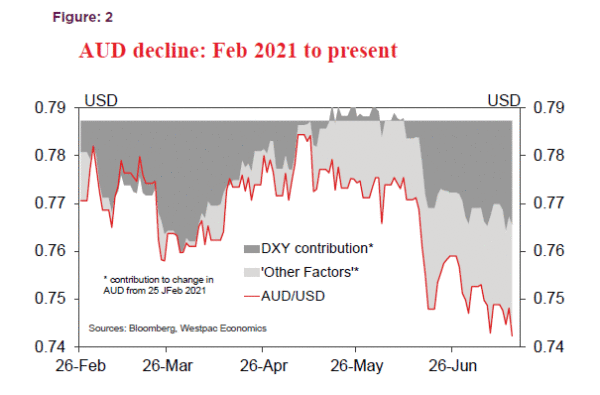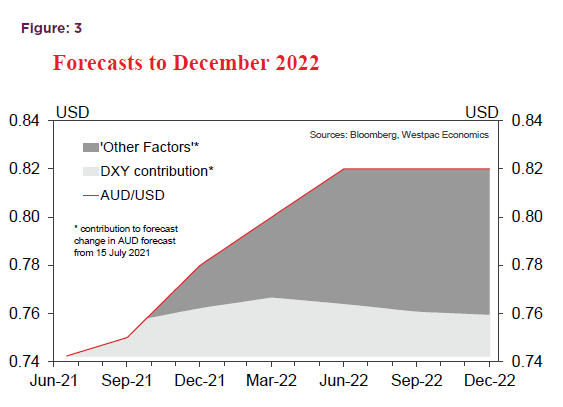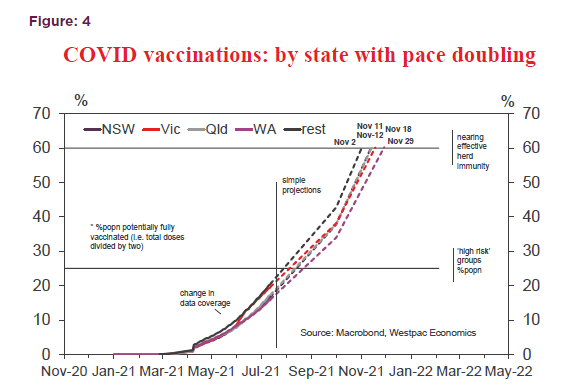Despite the fall in the AUD from around USD0.80 in February to the current USD0.74 we do not believe that the long term upswing in the AUD which began from around USD 0.60 last March has run its course.
Certainly, we have shaved our target levels for end 2021 from USD0.80 to USD0.78 and the target expected peak in the second half of 2022 from USD0.85 to USD0.82 but we are still expecting a solid net US 8¢ lift in the AUD from its current level over the course of the next year.
In the attached Figures 1–3 we allocate the movements in the AUD/USD between the USD itself (as measured by DXY) and “other factors” which are specific to the AUD. Figure 1, covers the period of recovery in the AUD from March 2020 to February 2021. It shows that only around 30% of the AUD strength was due to a weaker USD.
The ‘other factors’ that were boosting the AUD during that period were the 30% lift in Australia’s commodity price Index; global recognition of Australia’s outstanding success in dealing with Covid; an unexpectedly aggressive boost to fiscal policy; reluctance (until November) by the RBA to adopt quantitative easing; a non-negotiable stance by the RBA against negative interest rates; Australia’s rapid economic recovery with pre Covid activity levels being reached in the March quarter, ahead of its OECD rivals; and the usual benefit which AUD receives from markets’ acceptance of the strong global recovery underpinned by the rapid development of vaccines, supporting confidence in ‘risk on’ currencies.
Figure 2, shows the movement in AUD from that peak in February, highlighting the importance of the USD. AUD’s initial weakness in February – March period was largely due to the lift in US bond rates and the USD that unnerved the equity market weighing on ‘risk” currencies; those pressures gradually eased as markets backed off from the reflation trade; thereafter there was an emerging perception that while Australia had excelled at the first stage of the Covid crisis it was struggling with its vaccine rollout with fully vaccinated numbers for Australia falling well short of the other developed economies.
With AUD now looking vulnerable markets were also punishing the AUD on the basis of trade tensions with China even though Australia’s trade surplus with China had reached record levels
The RBA’s QE program was also weighing on the AUD. Markets were surprised when the Governor announced a second $100 billion QE program at the February 2 Board meeting while, a confident RBA Assistant Governor Kent speculated that QE had been responsible for AUD being 5% lower than otherwise would have been the case.
These ‘other factors’ were offsetting the further 20% lift we have seen in Australia’s Commodity Price Index since February. Markets may be taking this improvement for granted describing the commodity price out performance as a ‘known positive’ while anticipating that it would eventually fade.
Finally, as is clearly shown by Figure 2, a rising USD, in June, then played a key role in again weighing on AUD. Most of that move came after the FOMC meeting in June when AUD quickly fell from USD0.77 to USD 0.75 as markets reassessed a more hawkish stance from the FOMC.
In particular, the FOMC’s range of forecasts indicated an earlier than previously expected beginning to the rate hike cycle. By implication, markets also brought forward their timing for the tapering of the FOMC’s QE policy.
From the perspective of AUD, the markets seemed to ignore the stunning fall in Australia’s unemployment rate in May from 5.5% to 5.1% concentrating entirely on the revised outlook for the FOMC. At that time Westpac revised its policy rate outlook for both the RBA and the FOMC bringing forward the timing for the beginning of the rate hike cycles for both central banks. Our relative timing of the moves by the two central banks is similar to market pricing so not a significant factor in our outlook for the AUD.
Figure 3, shows our forecast for AUD, including the ‘contribution’ from the USD out to end 2022.
Readers will note that we are expecting a modest (around 3%) depreciation of the USD to the first half of 2022 after which USD appreciates somewhat.
Generally, our expectations for a lift in global optimism as vaccine distribution surges, will also weigh on the USD which is typically the ‘safe haven’ currency.
As discussed in our recent Market Outlook that modest depreciation will hinge on a relatively more aggressive wind back of QE by the ECB over the next six months. Thereafter we would expect the USD to appreciate as the ECB does not respond to the expected tightening cycle by the FOMC.
So the dominant reasons for the expected lift in AUD will come from ‘other factors’.
These factors are going to include Covid. It has been a drag on AUD in 2021 because of the slow vaccination program (see Figure 4) and lock downs. That failure has been due to a combination of vaccine complacency (Australians did not feel threatened by Covid due to very low number of cases); vaccine hesitancy (concerns with side effects of Astrazeneca); and a limited supply of Pfizer and Moderna.
The latest lock downs in Sydney and Melbourne are highlighting to Australians that vaccines are the only way to end the cycle of lock downs; the risk of catching Covid is more real under the delta strain; and the medical advice favours Pfizer and Moderna for those under 60.
Government advice points to adequate supply of Pfizer and Moderna through the second half of 2021. Optimistically Australia can be on track for 60% fully vaccinated (compared to the current 10%) by late November with the possibility of moving further although with 25% of the population under 20 there will be a natural limit to the proportion of population vaccinated.
Australia’s adult population could become one of the most highly vaccinated globally by the first quarter of 2022. That would be a Game Changer for Australia and the Confidence that would earn from markets
Just as Covid was a positive for AUD in 2020; a negative in 2021 to date; it is likely to pivot to being a significant positive from the December quarter and in 2022.
On July 6 the RBA announced that it will be tapering its purchases of bonds from the current pace of $5 billion per week to $4 billion from early September with a further review scheduled for the November Board meeting. We expect the decision will be made to further scale back purchases to $3 billion per week from November; falling to $2 billion from February with the program to be concluded by May. That would mean around $100 billion of purchases from September, down from the $150 billion we had previously expected.
An earlier than expected scaling back of the RBA’s QE program will support the AUD just as the faster than expected pace of QE in the first half of 2021 restrained the AUD.
While we expect commodity prices to ease back by around 10% in the first half of 2022 due to supply adjustments they will still hold at very high levels. Our Commodity Price Index is forecast to average around 295 in the first half of 2022.
Recall that in calendar 2012 when AUD/USD was consistently above parity the Index averaged around 305.
So while markets have been largely over looking Australia’s commodity price ‘windfall’ and focussing on the negatives around QE; Covid management; and China trade tensions the easing of these restraining forces (excluding the China tension issue) in 2022 is likely to refocus some attention on the commodity and current account story.
Globally, prospects for the boost to activity and confidence from the ever increasing coverage from vaccines, is also likely to support risk currencies such as AUD and CNY with the associated spill over to other developing world currencies in preference to the ‘safe haven’ currencies.
We are expecting this uplift in the AUD but Australia’s current malaise, with lock downs and low vaccination rates, is likely to weigh on AUD until we gain sufficient vaccine coverage.
We have revised back our forecast for AUD by September 2021 from USD0.78 to USD0.75 and recognise that during the September quarter there will be significant volatility.
Markets are also likely to overestimate the damage done to the Australian economy over this period. Governments are committed to strong support, particularly given the sharp improvements in the underlying fiscal position, momentum outside NSW is strong while there is ample evidence that economies bounce back from snap lockdowns on government support and pent up demand. Nevertheless that is likely to mean significant volatility.
With high levels of vaccination expected by end November we expect that governments will be much more cautious in resorting to lock downs, laying the foundations for the US3¢ lift in AUD by year’s end.
















